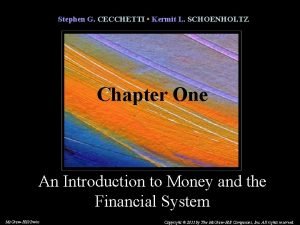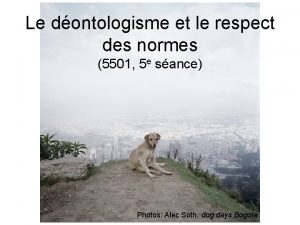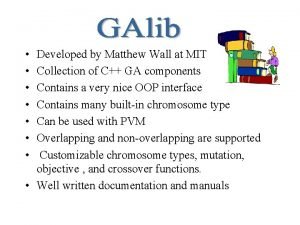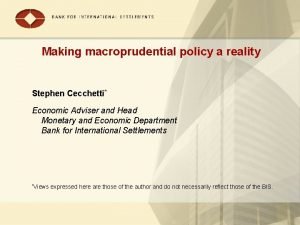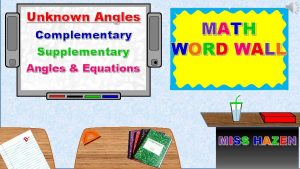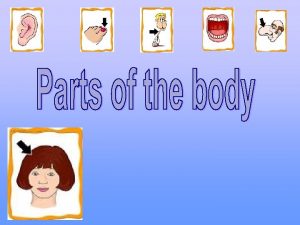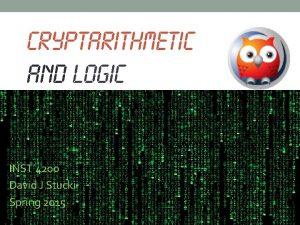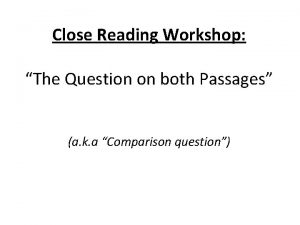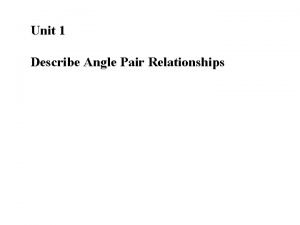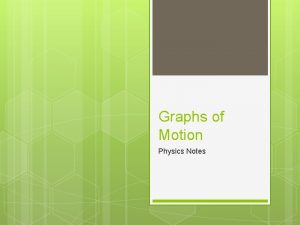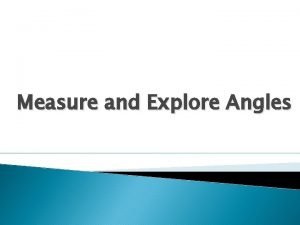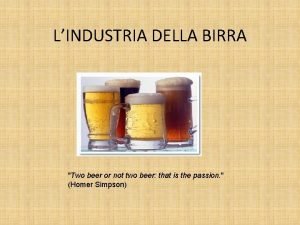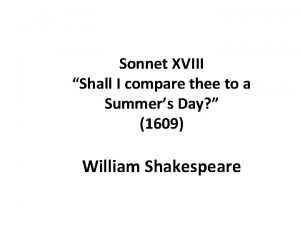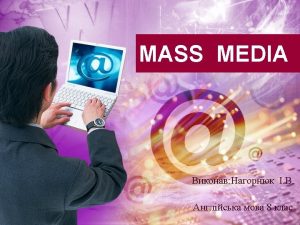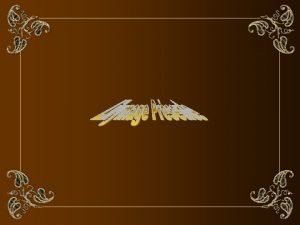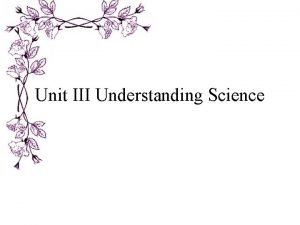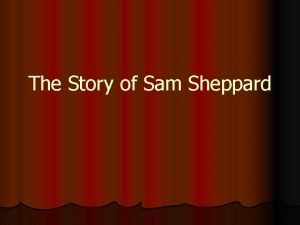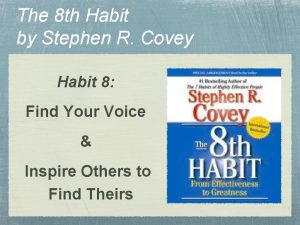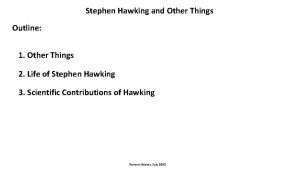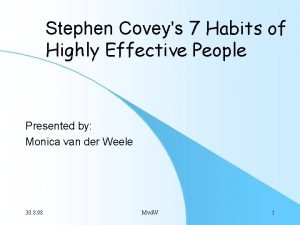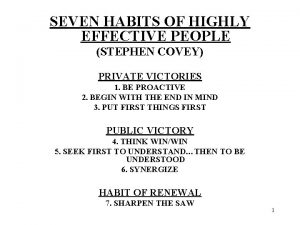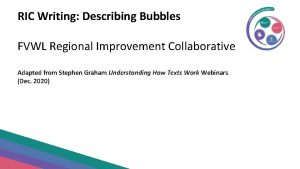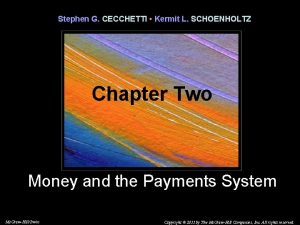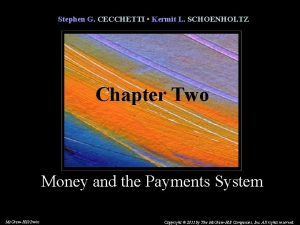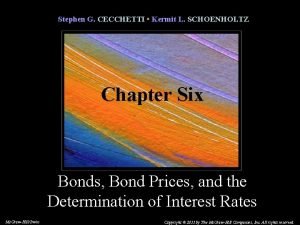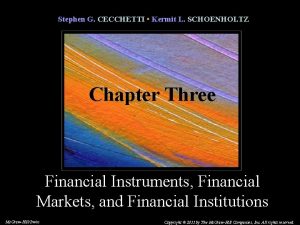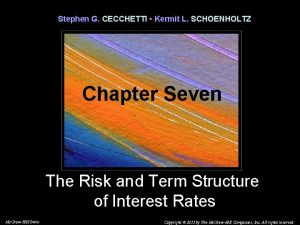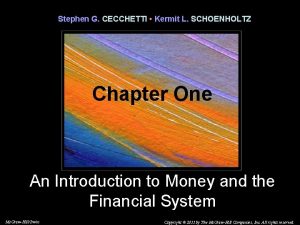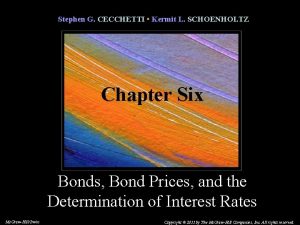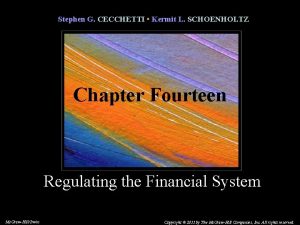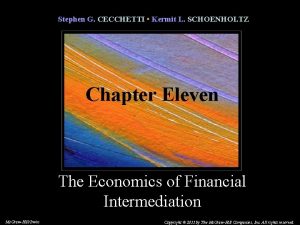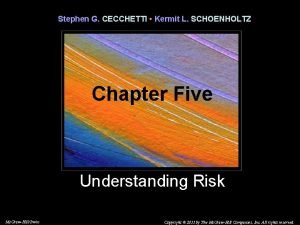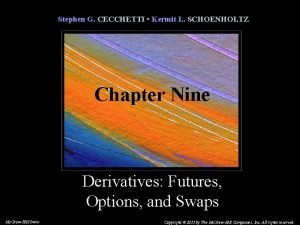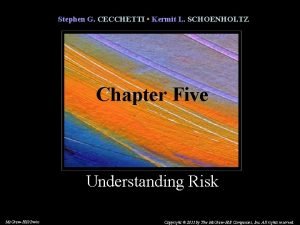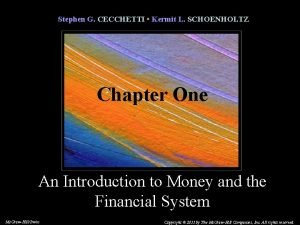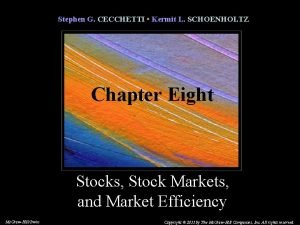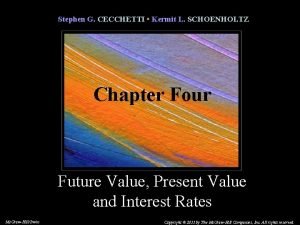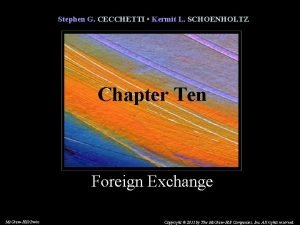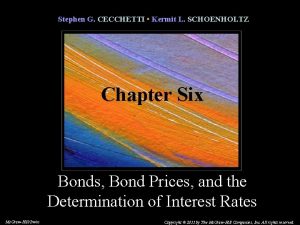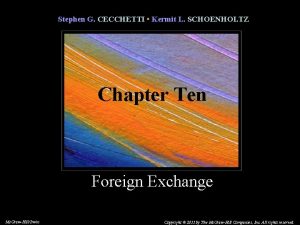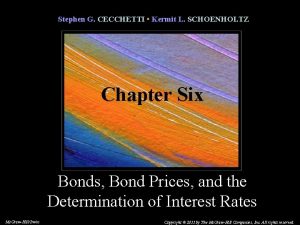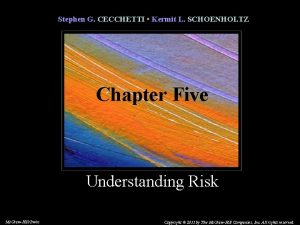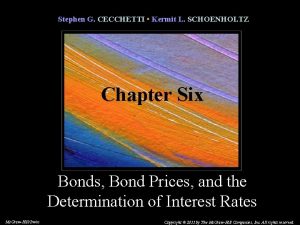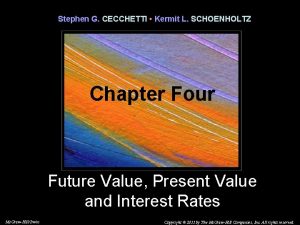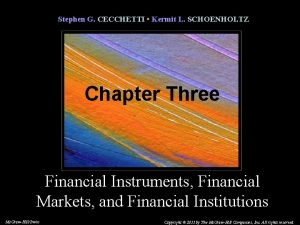Stephen G CECCHETTI Kermit L SCHOENHOLTZ Chapter Two















































- Slides: 47

Stephen G. CECCHETTI • Kermit L. SCHOENHOLTZ Chapter Two Money and the Payments System Mc. Graw-Hill/Irwin Copyright © 2011 by The Mc. Graw-Hill Companies, Inc. All rights reserved.

Goals of the Chapter • To understand what money is. • To understand how we use money. • To understand how we measure money. 2 -2

Money and How We Use It • Money is an asset that is generally accepted as payment for goods and services or repayment of debt. • Income is a flow of earnings over time, where wealth is the value of assets minus liabilities. 2 -3

Money and How We Use It Money has three characteristics: 1. It is a means of payment 2. It is a unit of account, and 3. It is a store of value. The first of these characteristics is the most important 2 -4

Money and How We Use It 1. It is a means of payment • People insist on payment in money. • • Barter requires a “double coincidence of wants”. Money is easier and finalizes payments so no further claim on buyers and sellers. 2 -5

Money and How We Use It 2. It is a unit of account. • Money is used to quote prices and record debts - it is a standard of value. • Prices provide the information needed to ensure resources are allocated to their best uses. • Using dollars makes relative price comparisons easier. 2 -6

• When you shop, should you use a debit card or a credit card? • A debit card works like a check only faster. • Funds are immediately removed from your account. • A credit card makes a deferred payment. • If not paid on time, there is a late fee. • If not paid fully, there is interest on the debt. • But if you do pay on time and fully, it is an interest free loan for a period of time. • Credit cards allow you to build a credit history. 2 -7

Money and How We Use It 3. It is a store of value • A means of payment has to be durable and capable of transferring purchasing power from one day to the next. • Paper currency does degrade, but is accepted at face value in transactions. • Other forms of wealth are also a store of value: stocks, bonds, houses, etc. 2 -8

Money and How We Use It 3. Store of Value (cont. ) • Although other stores of value are sometimes better than money, we hold money because it is liquid. • Liquidity is a measure of the ease with which an asset can be turned into a means of payment. • The more costly it is to convert an asset into money, the less liquid it is. 2 -9

Money and How We Use It • It is a store of value (cont. ) • Financial institutions use: • Market liquidity - the ability to sell assets for money. • Funding liquidity - ability to borrow money to buy securities or make loans. 2 -10

The Payments System • The payments system is a web of arrangements that allow for the exchange of goods and services, as well as assets. • It is critical this functions well. • Money is at the heart of the payments system. 2 -11

The Payments System The possible methods of payment are: 1. Commodity and Fiat Monies 2. Checks 3. Electronic Payments 2 -12

Commodity and Fiat Monies • Commodity monies are things with intrinsic value. • Included items like silk and salt. • To be successful, must be: • • • Usable by most people, Able to be made into standardized quantities, Durable, Easily transportable, and Divisible into smaller units. 2 -13

Commodity and Fiat Monies • Gold has been the most common as it meets these requirements. • In 1656, Stockholm Banco issued Europe's first paper money • King of Sweden printed too many to try to finance a war and the bank failed. • In 1775, the Continental Congress of the United States of America issues “continentals” to finance the Revolutionary War. 2 -14

Commodity and Fiat Monies • Because of huge quantities issued, people became suspicious of government-issued paper money. • In 1862, the Confederate and the Union governments printed money with no backing. • After the Civil War, the US reverted to using gold as money. 2 -15

Commodity and Fiat Monies • Gold coins and notes, backed by gold, were used into the 20 th century. • Today’s paper money is called fiat money, because its value comes from government decree, or fiat. • We are willing to accept these bills as payment because the US government stands behind its paper money. • In the end, money is about trust. 2 -16

Checks • A check is an instruction to the bank to take funds from your account and transfer them to another account. • A check is therefore not a final payment as currency is. • A check sets in motion a series of transactions as seen in Figure 2. 1. 2 -17

Figure 2. 1: The Path of a Paper Check 2 -18

• Why have checks not disappeared? • Checks are legal proof of payment. • Customers wanted them back. • Starting in 2004 • Banks can transmit digital images. • Substitute checks are proof of payment. • Electronic mechanisms for clearing checks have lowered costs and kept checks as an attractive means of payment. 2 -19

Electronic Payments • Electronic payments take the form of: • • Credit and debit cards Electronic funds transfers Stored-value card E-money 2 -20

Electronic Payments • Debit Cards • Works like a check - tells the bank to transfer funds from your account to another. • Credit Cards • A promise by a bank to lend the cardholder money to make a purchase. • They do not represent money. 2 -21

Electronic Payments • Electronic funds transfers • Movements of funds directly from one account to another. • Most common form is the automated clearinghouse transaction (ACH). • Used for recurring payments like paychecks. • Banks use electronic transfers for bank to bank transactions, sending money through Fedwire. 2 -22

Electronic Payments • Stored-value card • Take it to a bank or an ATM, transfer money to the card, then use the card at a merchant. • Limited usefulness so far. • Limited in what can be purchased with them. • Require specific hardware. 2 -23

Electronic Payments • E-money • Can be used to pay for purchases on the Internet. • You open an account by transferring funds to the issuer of the e-money. • When shopping online, you instruct the issuer to send your e-money to the merchant. • Really a form of private money. 2 -24

• Market liquidity and funding liquidity are both needed to market financial markets function smoothly. • 2007 -2009 financial crisis lead to a sudden loss of liquidity. 2 -25

• Before the crisis • Financial institutions relied on short-term borrowing to hold long-term financial instruments. • They believed funding liquidity would remain readily available. • They also believed markets would also be liquid. • They would always be able to sell the securities and loans they held. 2 -26

• In 2007, doubt lead to a double “liquidity shock” increasing cash holdings. • This reduced loan supplied intensifying the decreasing liquidity. • One lesson: Liquidity is a highly valuable resource that can disappear when most needed. 2 -27

2 -28

The Future of Money • The future of the three functions of money: • Means of payment: disappearing due to ease of electronic transactions. • Unit of account: likely to remain. • Will always be needed to quote values and prices because it is efficient. • But, will we move to one global unit of account? • Store of value: disappearing due to liquidity of many financial instruments. 2 -29

• Technological advances create new methods of payment. • Cell phones and other types of hand-held mobile devices are providing access to the payments system. • What will be next? 2 -30

Measuring Money • Changes in the quantity of money are related to • Interest Rates • Economic Growth • Inflation 2 -31

Measuring Money • Inflation: • The process of prices rising. • Inflation rate: • The measurement of the process. • With inflation, you need more money to buy the same basket of goods. • The primary cause of inflation is too much money. 2 -32

Measuring Money • The value of the means of payment depends on how much of it is circulating. • We therefore must be able to measure how much is circulating. • Defining money means defining liquidity (see figure 2. 2). 2 -33

Figure 2. 2 - The Liquidity Spectrum 2 -34

Measuring Money Different definitions of money are based upon degree of liquidity. Drawing the line in different places has led to several measure of money called the money aggregates: M 1 and M 2. M 1: Narrowest definition. Only the most liquid assets. M 2: Broader definition. Includes assets not used as means of payment. 2 -35

Table 2. 1: The Monetary Aggregates 2 -36

Measuring Money • What do the money aggregates mean? • As of winter 2010, nominal US gross domestic product (GDP) was $14, 500 billion. • Using the data in Table 2. 1 above: • GDP is nearly nine times as large as M 1. • GDP is about 70 percent larger than M 2. 2 -37

Measuring Money • Which M do we use to understand inflation? • Until the early 1980’s we used M 1. • But with changes in accounts, M 2 became more useful. • M 2 represents nearly one-half of GDP, so M 1 is no longer a useful measure of money. • Figure 2. 3 shows the M’s growth rates. 2 -38

Figure 2. 3: Growth Rates of the Money Aggregates 2 -39

Measuring Money • How useful is M 2 in tracking inflation? • When the quantity of money grows quickly, it produces high inflation. • Figure 2. 4 shows the inflation rate versus M 2 two years earlier for the US. • Positive correlation up until 1980. • From 1990 -2000 - no correlation. • Growth in M 2 stopped being a useful tool forecasting inflation. 2 -40

Figure 2. 4: Money Growth and Inflation 2 -41

Measuring Money • Why does M 2 no longer predict inflation? • Maybe the relationship only applies at high levels of inflation. • Maybe it only shows up over longer periods of time. • Maybe we need a new measure of money. • We do know that at low levels of money growth, inflation is likely to stay low. 2 -42

• The CPI answers the question: “How much more would it cost for people to purchase today the same basket of goods and services that they actually bought at some fixed time in the past? ” 2 -43

• Computing CPI Inflation • Survey people to see what they bought. • Figure out what it would cost to buy the same basket of goods & service today. • Compute the percentage change in the cost of the basket of goods. 2 -44

Table 2. 2: Computing the Consumer Price Index 2 -45

• In 2009 the public held about $880 billion in US currency. • You can compare this to each person holding $2800. • 80% of this money was in $100 bills. • Many of these bills are in other countries. • People in other countries hold other currencies that are more stable than their own. 2 -46

Stephen G. CECCHETTI • Kermit L. SCHOENHOLTZ End of Chapter Two Money and the Payments System Mc. Graw-Hill/Irwin Copyright © 2011 by The Mc. Graw-Hill Companies, Inc. All rights reserved.
 Cecchetti schoenholtz
Cecchetti schoenholtz Kermit vandivier
Kermit vandivier One more sleep til christmas
One more sleep til christmas Ethan cecchetti
Ethan cecchetti Dr matthew schoenholtz
Dr matthew schoenholtz Steve cecchetti
Steve cecchetti Complementary and supplementary angles formula
Complementary and supplementary angles formula 2 hands go
2 hands go Osha 1910 134
Osha 1910 134 Two + two = four cryptarithmetic solution
Two + two = four cryptarithmetic solution The author of both passages agree that
The author of both passages agree that Angle pair relationships
Angle pair relationships When two curves coincide the two objects have the same
When two curves coincide the two objects have the same Identify a key term used in both passages.
Identify a key term used in both passages. Vertical angles
Vertical angles Maltificazione
Maltificazione Hamlet act 2 scene 2 summary
Hamlet act 2 scene 2 summary Alan alexander milne
Alan alexander milne Two by two table
Two by two table Shall i compare thee to a summer's day annotation
Shall i compare thee to a summer's day annotation If 2 witches had 2 watches
If 2 witches had 2 watches Two beer or not two beer shakesbeer
Two beer or not two beer shakesbeer Malcolm macbeth description
Malcolm macbeth description Who's who characters
Who's who characters Stephen poplawski
Stephen poplawski Stephen hawking
Stephen hawking Stephen sheppard lawyer
Stephen sheppard lawyer Stephen ngan
Stephen ngan Stephen crane the open boat summary
Stephen crane the open boat summary The human camera
The human camera Mark fitzpatrick utsc
Mark fitzpatrick utsc Th habit
Th habit Emotional bank account 7 habits ppt
Emotional bank account 7 habits ppt Stephen illingworth
Stephen illingworth Strawberry spring setting
Strawberry spring setting Stephen hawking william smith
Stephen hawking william smith Stephen oluwole awokoya
Stephen oluwole awokoya Stephen king monash
Stephen king monash Stephen hawking cbe
Stephen hawking cbe Stephen hawking
Stephen hawking Hawking
Hawking Covey's 7 habits model
Covey's 7 habits model Stephen hawking bolezen
Stephen hawking bolezen Inside out approach 7 habits
Inside out approach 7 habits General classes of victims by hans von hentig
General classes of victims by hans von hentig Stephen ludin
Stephen ludin Stephen graham description bubble
Stephen graham description bubble Quantum information stephen m. barnett
Quantum information stephen m. barnett
